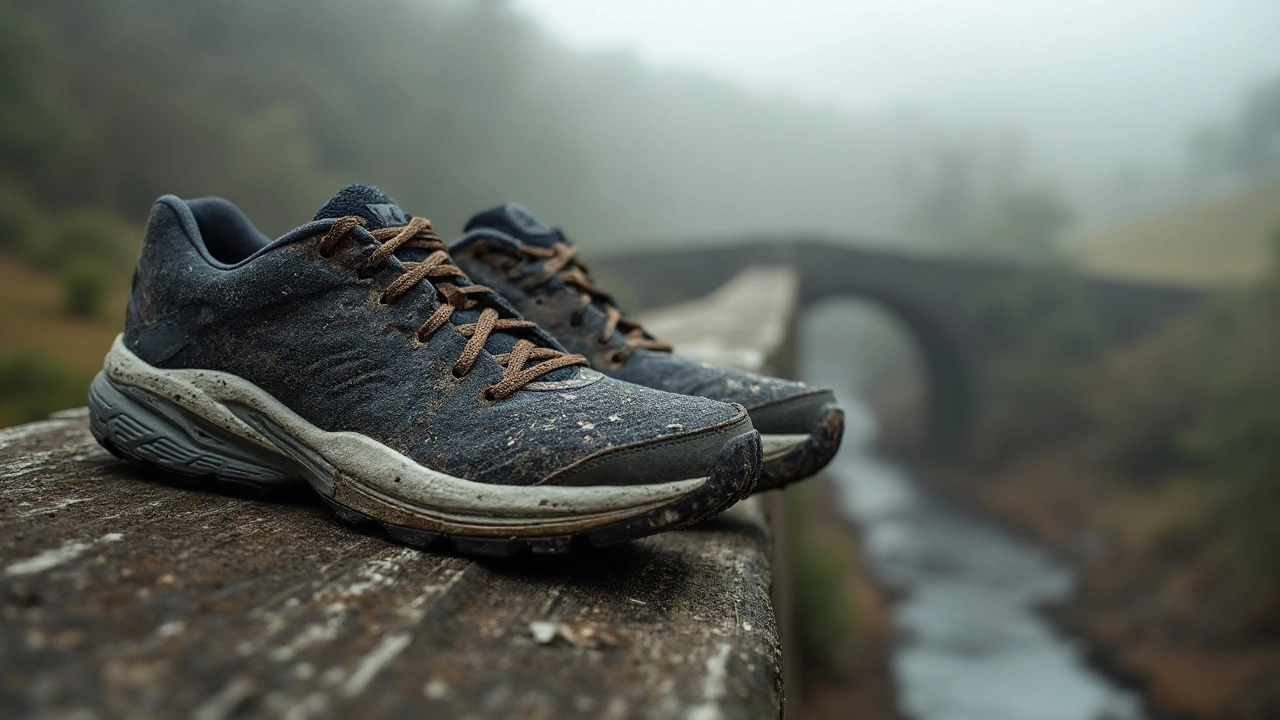Ever wonder if those trusty running shoes still have some miles left, or are they just waiting to wreck your next run? We’ve all been there—staring at our favorite pair, trying to decide if they’re still good or if it’s time to move on. Knowing when to replace your running shoes isn’t always straightforward, but a few hints can make it easier.
First things first, the average lifespan of running shoes is usually between 300 to 500 miles. That sounds like a pretty big range, doesn’t it? But it all depends on factors like the type of shoe, your running style, and the surfaces you usually hit. For some, this could mean swapping them out every six months, while others might stretch it to a year.
If you’re logging miles like a marathoner, you might want to keep a close eye on those soles. Uneven wear, less spring, and even new aches might be telling you it’s time for a fresh pair. Don’t just rely on looks, though; sometimes shoes can appear fine but have lost their support. Let’s dive into how to tell if your running shoes are running out.”
- Understanding Shoe Lifespan
- Signs Your Shoes Are Worn Out
- Mileage Matters
- The Importance of Terrain and Running Style
- When It's Time to Say Goodbye
Understanding Shoe Lifespan
When it comes to running shoes, they're not built to last forever. But how do you know when they've reached the end of their life? The typical range is around 300 to 500 miles for most running shoes. Yeah, it seems like a lot but think about how quickly those miles add up with regular runs. But those numbers can vary based on a few things.
First off, your running shoes might wear out faster if you're pounding concrete all the time. Hard surfaces can be tough on them, while trails can be a little more forgiving. And if you're a heavy-footed runner or have a unique gait, you'll notice they wear out differently too. Keep an eye on wear patterns; they can actually tell you a whole lot about your shoes’ health. This could mean uneven wear on the inside or outside edges or excessive wear on the heels.
Factors Affecting Shoe Lifespan
Let's break it down a little more:
- Surface: Running on tough surfaces? Your shoes might wear quicker.
- Weight: Heavier runners often find their shoes wear out a bit faster.
- Frequency: Running almost every day? You might need to replace shoes more often.
- Your Form: Those special little quirks in how you run? They influence wear too.
Here's a neat little detail—a study found that runners hitting over 20 miles a week often needed to replace their shoes every 4 to 6 months. It’s a great ballpark figure if you’re clocking in those weekly miles.
Remember this: Wear might show on the outside, but the real cue is often inside the shoe. The midsole, the bit that provides cushioning and support, loses its mojo over time. You might not see it, but you'll definitely feel it when it’s gone.
Using a shoe tracking app or just keeping a simple log can help pinpoint when it's time to replace your running gear. If you're not sure about your shoe’s mileage and feel discomfort, it might be your shoes crying for a break.
Signs Your Shoes Are Worn Out
So, how do you actually know when your trusty running shoes are past their prime? It’s not just about how they look, but how they feel and function, too. Let’s break down some tell-tale signs that your shoes are ready to retire.
Sole Woes
Take a good look at the outsoles, those parts of the shoe that take the brunt of your running. If you notice uneven wear patterns, it might be throwing off your gait and possibly causing injuries. Worn-out treads mean less grip and stability, which isn’t ideal when you’re aiming for peak performance.
Losing Cushion
The cushioning in your shoes is probably the most critical part. Over time, it compresses and loses the ability to absorb shock, leading to discomfort and potential joint pain. A simple test? Try pressing your thumb into the midsole. If it’s not as springy and responsive as it used to be, that’s a major red flag.
Pain Points
Aches and pains cropping up out of nowhere? Your running shoes might be to blame. Shoes no longer providing support can lead to foot, knee, or even lower back pain. Listen to your body—it’s often the first indicator that something’s off.
- Abrupt increase in blisters or hot spots.
- Shoes feel flat or non-responsive.
- Soles look visibly worn or uneven.
The Mileage Check
If you're a data geek, keeping track of your running mileage can be a lifesaver. Logging around 300 to 500 miles is the accepted range for replacing running shoes. So, if you're hitting the high end, start shopping.
| Runner Type | Mileage for Replacement |
|---|---|
| Casual Runner | 500 miles |
| Frequent Runner | 300 miles |
Pay attention to these signs, and you’ll save yourself from unnecessary discomfort and keep your runs as smooth as ever.

Mileage Matters
Alright, let's chat about why mileage is such a big deal when figuring out if your running shoes are ready for retirement. You know how even a reliable car will start acting up if you’ve clocked too many miles? Well, running shoes are a bit like that. Most experts suggest you swap out your shoes anywhere between 300 to 500 miles. That's an average and depends on how and where you run.
But why those numbers? The materials like cushioning and sole support break down over time. Without these key features, your shoes won't absorb the shock of running, potentially leading to injuries. Some folks even recommend keeping a running log or using an app to track the miles on each pair of shoes. It's not about being fancy, it's about protecting those feet and keeping your running game strong.
How Do You Know You’ve Hit the Limit?
Look at the soles—if they’re worn unevenly or flat in spots, you might’ve run their life out. Also, the shoes may feel less springy, and you could notice new aches or pains in your feet or knees. In doubt? Try them on a run you know well, and pay attention to any discomfort.
A Quick Peek at the Numbers
| Shoe Type | Mileage Range |
|---|---|
| Road Running Shoes | 300-500 miles |
| Trail Running Shoes | 300-400 miles |
| Lightweight/Minimalist Shoes | 250-300 miles |
These numbers are just a guideline, but they’re a good start. Remember, everyone runs differently, so what works for one person might not work for you. Pay attention to how your shoes feel and perform during runs—that’ll be your best guide.
In the end, it all comes down to listening to your body. If your running shoes feel off, they probably are. Trust yourself and step into a new pair if needed!
The Importance of Terrain and Running Style
When it comes to how long your running shoes last, where you run can make a huge difference. Hitting the pavement is going to wear your shoes down differently than jogging on a trail. Let’s break it down a bit.
Running Surface
If you're mostly running on paved roads, you’re going to experience more wear and tear on your shoe soles because pavement is pretty unforgiving. It’s flat and hard, which can compress your shoe’s midsole quickly. On the flip side, trails and softer surfaces, while easier on your shoe’s sole, have other challenges. Rocks, mud, and debris can tear up the fabric of your shoes faster.
Here's a quick example. A buddy of mine swears by trails for training. He claims his trail shoes always look like they've returned from a battle but tend to last a bit longer than his road running ones. This isn't a hard and fast rule but something you might notice too.
Running Style
Then there's how you run. If you're a heel-striker, you’ll notice the back of your shoes wearing out faster. But if you’re more of a forefoot runner, you might wear out the balls of your shoes quicker. Different styles of running put different pressures on parts of the shoe, which can lead to uneven wear. Recognize this pattern early, and you might catch potential issues with your running shoes before they become a real problem.
For instance, an alteration in your stride might save your shoes and your knees. A small change in running dynamics could help them last longer and keep you more comfortable.
| Terrain | Average Shoe Lifespan |
|---|---|
| Pavement | 300-400 miles |
| Trail | 400-500 miles |
Keeping an eye on these factors and understanding their impact on the lifespan of your running shoes can help you plan your purchases better and ensure that your runs are nothing short of fantastic.

When It's Time to Say Goodbye
Parting ways with your favorite pair of running shoes can be tough. But holding onto worn-out shoes might do more harm than good, so let’s figure out when to let them go.
All About Wear Patterns
Check out the bottoms of your shoes. If the treads are more worn in some spots than others, you’re looking at uneven wear. This not only affects grip but also alters the shoe's support, which can lead to injuries.
Midsole Compression
The midsole is that squishy layer that gives your shoes their bounce. Press down on this section. If it doesn’t spring back like it used to, or if you can see visible creases and cracks, the cushioning might be shot.
Mileage Makes a Difference
Remember that 300 to 500-mile guideline? It’s a good starting point. An easy way to keep track is by marking the date of first wear and using a running app to log miles. Once you’re in the ballpark of that magic number, it might be time for a new pair.
Comfort Level Dropping?
If you start noticing blisters, pain in your feet or even in other areas like knees and hips — it's a big red flag. Your running shoes are likely lacking support and protection.
| Indicators | Signs to Replace |
|---|---|
| Tread Wear | Worn down in spots |
| Midsole | Lacks bounce, visible creases |
| Foot Comfort | Increased blisters, pains |
Look and Listen
Look for tiny holes or clear signs of tearing. Also, give your shoes a bend test. If they flex too easily, the structure might be compromised.
Saying goodbye doesn’t mean throwing the shoes out completely. Keep them for casual use, gardening, or short walks. But when it comes to running, getting fitted for a new pair can make a world of difference for your comfort and performance.








